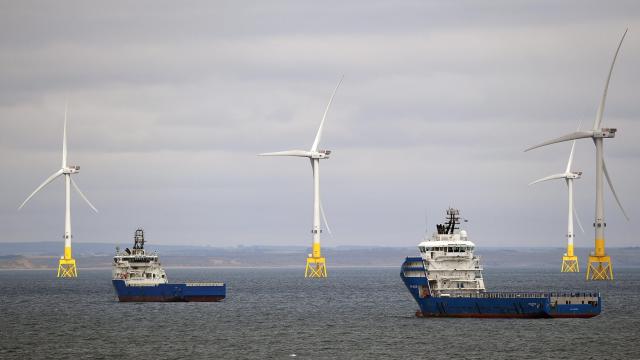Everything’s coming up floating wind turbines. On Tuesday, the Biden administration announced plans to open up the waters off California to wind energy, signalling that the new technology is going to emerge.
“Today’s announcement reflects months of active engagement and dedication between partners who are committed to advancing a clean energy future,” Interior Secretary Deb Haaland said in a statement.
The proposal allows developers to site commercial-scale offshore wind farms in two locations, one in Morro Bay off central California and another off the coast of Humboldt near the state’s northern coast. Together, the administration said the locations could generate enough electricity to power 1.6 million homes. Remarkably, the scheme received support from the military, which uses California’s coast for testing and operations and has previously dismissed such plans. But though it cleared that major barrier, erecting offshore wind farms in the Pacific could also come with physical difficulties.
Globally, most offshore wind has been constructed in shallow waters where turbines can be attached to the seafloor with concrete or steel. But the underwater topography along the West Coast drops off more quickly, which rules out anchored wind towers. So developers will have to come up with new ways to harness the power of the wind there.
Enter floating wind turbines, which are tethered with cables instead of stiff pilings. To stop them from drifting too far away, chains and weights can be added to anchors which can latch onto the ocean floor. In Wednesday’s announcement, the White House said “new floating offshore wind technology will be deployed in offshore California waters.”
This technology can allow developers to access faster and more consistent wind energy than their more fixed counterparts. It could also increase the world’s capacity to generate wind power since only an estimated 40% of offshore wind resources can be captured with fixed-bottom turbines.
This technology is relatively new. The world’s first floating wind farm started producing power in late 2017 off the coast of Scotland. Since then, roughly 20 more have been brought to fruition, but none are in the U.S. or operating at a commercial scale. Developers in Maine are currently pushing to bring a floating wind farm online, but it’s been a real uphill battle, so California might end up being the first in the nation to deploy this technology.
“While interest from the global industry will be unprecedented, West Coast development requires American ingenuity and innovation in next generation technologies that will create opportunities for engineering firms and skilled labour,” Liz Burdock, president and CEO of the Business Network for Offshore Wind, said in an emailed statement.
Developers are ready for the floating turbine future. In fact, several have already shown their interest in the region. A coalition including Magellan Wind and Orsted North America is gunning to construct turbines in California waters. And Trident Winds and EnBW North America have proposed a 1,000-megawatt floating farm near Morro Bay, though the companies have encountered opposition from the fishing industry, similar to what’s played out in Maine.
This week during a summit hosted by the Department of Energy, General Electric also announced that its researchers are working on a concept for a 12-megawatt floating farm. If the firm’s models and simulations pan out to provide proof of concept for the project, it may move forward with partners to build a prototype.
The floating wind market is expected to take off in the coming years, and the Biden administration wants to help it along. In a Tuesday statement, the White House said the Department of Energy “has invested more than $US100 ($128) million in researching, developing, and demonstrating floating offshore wind technology.”
Once the Bureau of Ocean Energy Management officially sets aside the areas off the California coast for development and conducts an environmental analysis, the agency plans to auction off leases for the area to developers in mid-2022. If this new technology becomes a reality in the U.S., it could mean California becomes one of the largest global generators of wind power, and bring the U.S. closer to the Biden administration’s goal of reaching 100% no-carbon electricity by 2035.
